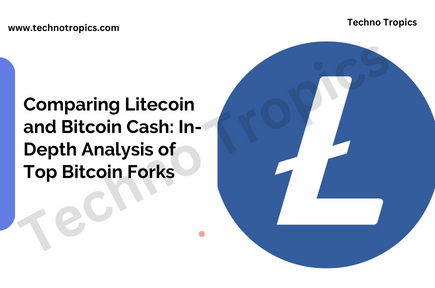With their own features and future goals, Litecoin and Bitcoin Cash have become well-known forks of the original Bitcoin blockchain in the constantly changing world of cryptocurrencies.
This investigation sets out on an extensive voyage, dissecting the workings of Litecoin and Bitcoin Cash and examining their influence on the larger cryptocurrency landscape.
With speedier transactions, scalable solutions, and distinct mining algorithms distinguishing these forks, users and investors are faced with decisions that ripple throughout the decentralized ecosystem.

Come along as we go deeply into the minute details, looking at the characteristics that make these forks unique and the significant effects they have on the constantly shifting landscape of digital currency.
The first cryptocurrency, Bitcoin, created the framework for a whole ecosystem. But as the community expanded, different viewpoints about transaction speed, scalability, and mining techniques gave rise to forks.
Prominent substitutes like Litecoin and Bitcoin Cash have surfaced, each with an own outlook on the direction of virtual money.
Often called the “silver to Bitcoin’s gold,” Litecoin was founded in 2011 by Charlie Lee. While it is quite similar to Bitcoin, it also adds some significant modifications to address several flaws.
Notably, transaction confirmations occur faster with Litecoin due to its faster block production time of 2.5 minutes as opposed to 10 minutes for Bitcoin.
Scrypt, the mining algorithm, is made to be more resistant to ASIC mining, which encourages a more decentralized mining environment.
After a controversial hard fork in 2017, Bitcoin Cash was created with the goal of raising the block size limit in order to solve Bitcoin’s scalability problems.
Compared to Bitcoin’s 1 MB block size, the 32 MB block size allows for more transactions per block, resulting in higher throughput.
This method is a candidate for everyday transactions and peer-to-peer cash transfers since it aims to speed up transactions and cut costs.
The main difference between Bitcoin Cash and Litecoin is the mining algorithm used.
ASIC miners’ supremacy was discouraged and a more decentralized mining ecosystem was promoted via Litecoin’s memory-intensive Scrypt algorithm.
In contrast, Bitcoin Cash maintained the original SHA-256 algorithm of Bitcoin, demonstrating its dedication to the stability and security offered by ASIC mining.
Segregated Witness (SegWit) is a protocol upgrade that Litecoin was one of the first to execute. Its goal was to increase block capacity and make it possible to add second-layer scaling solutions such as the Lightning Network.
SegWit solves transaction malleability as well, enhancing the blockchain’s overall effectiveness. In contrast, Bitcoin Cash first opposed the introduction of SegWit, which resulted in several strategies for handling scalability.
The cryptocurrency community has shown a great deal of support for both Litecoin and Bitcoin Cash, each with a distinct group of supporters.
Users looking for efficient transactions and decentralized mining are drawn to Litecoin because of its faster block times and dedication to ASIC resistance.
Bitcoin Cash presents itself as a peer-to-peer electronic cash system by focusing on bigger blocks and less transaction costs.
Because Litecoin generates blocks more quickly, transactions are confirmed more quickly, which makes it appropriate in situations where speed is of the essence.
Because it can handle more transactions per block due to its bigger block size, Bitcoin Cash may be able to minimize congestion and costs during times of high demand. The trade-off between block size and transaction speed determines the user’s preference for each fork.
A key component of the cryptocurrency market is price performance, and both Litecoin and Bitcoin Cash have gone through phases of expansion and volatility.
The valuation of these forks is influenced by various factors, including market sentiment, technological advancements, and acceptance.
In order to make wise judgments in the always changing cryptocurrency market, traders and investors keep a careful eye on these trends.
Litecoin and Bitcoin Cash are not exempt from difficulties and disputes, just like other cryptocurrencies.
Charlie Lee, the creator of Litecoin, came under fire after he sold his cryptocurrency assets, raising concerns about possible conflicts of interest.
The 2018 hard fork of Bitcoin Cash, which resulted in the formation of Bitcoin SV, exposed divisions among the community.
It is imperative that these obstacles be overcome in order to preserve confidence and ensure the long-term sustainability of these forks.
Future developments, community involvement, and the ability to tackle new obstacles will determine how Litecoin and Bitcoin Cash flourish as they coexist with Bitcoin and other cryptocurrencies.
Forks must change to keep up with technology breakthroughs, legislative developments, and user preferences in order to be important contributors to the larger blockchain ecosystem. The cryptocurrency space is dynamic.
Disclaimer: The information provided in this article is for informational purposes only and should not be considered financial or investment advice. Always conduct your research before making any financial decisions.


